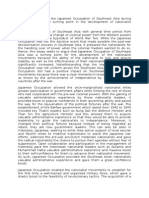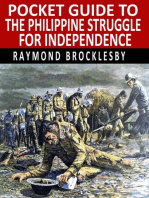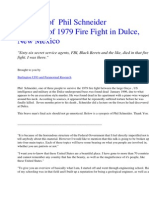Japanese Invasion
Japanese Invasion
Uploaded by
Abie Gaile Juanico CasioCopyright:
Available Formats
Japanese Invasion
Japanese Invasion
Uploaded by
Abie Gaile Juanico CasioOriginal Title
Copyright
Available Formats
Share this document
Did you find this document useful?
Is this content inappropriate?
Copyright:
Available Formats
Japanese Invasion
Japanese Invasion
Uploaded by
Abie Gaile Juanico CasioCopyright:
Available Formats
Japanese Invasion
Experiences of the Filipino People:
A. Harsh Occupation: The Japanese occupation was characterized by brutality, forced labor, and
widespread suffering among the Filipino population.
B. Resistance Movements: Despite the risks, Filipinos engaged in various forms of resistance, including
guerrilla warfare and underground movements
.C. "Comfort Women": The occupation also saw the tragic exploitation of Filipino women as "comfort
women" by Japanese military personnel.
Reference:
Agoncillo, Teodoro A. "The Fateful Years: Japan's Adventure in the Philippines, 1941-1945." Quezon City:
University of the Philippines Press, 1995 (https://digitalcommons.usu.edu)
After the Japanese surrender in the Philippines in 1945, the country faced significant challenges in the
post-war period. The transition from Japanese occupation to liberation marked the beginning of a
process of reconstruction, rehabilitation, and the restoration of Filipino sovereignty.
Role of American Forces in Liberation:
After the Japanese surrender in 1945, American forces played a pivotal role in the liberation of the
Philippines. General Douglas MacArthur famously returned to the Philippines in October 1944, fulfilling
his promise to return. American troops, along with Filipino guerrillas, engaged in intense battles to drive
out the remaining Japanese forces. The liberation process involved extensive military campaigns across
the archipelago, culminating in the liberation of Manila in early 1945.
Return of Filipino Exiles:
With the liberation of the Philippines, many Filipinos who had fled the country during the Japanese
occupation began to return. These returning exiles included government officials, intellectuals, and
leaders who played key roles in the post-war reconstruction efforts. Their return contributed to the
reestablishment of governance and institutions in the country.
Establishment of a New Government:
The Philippines underwent significant political changes after the Japanese surrender. In 1943, during the
Japanese occupation, the Philippines had been declared a "puppet state" with a government under
Japanese control. After liberation, the Philippine Commonwealth government, led by President Sergio
Osmeña, was reestablished. This period marked a transition toward full independence, which was
achieved on July 4, 1946, when the Philippines became a sovereign republic.
Reconstruction and Rehabilitation:
The war had left the Philippines with extensive damage to infrastructure, the economy, and
communities. The post-war period was marked by efforts to rebuild the nation. The United States
provided assistance and aid, and international organizations such as the United Nations Relief and
Rehabilitation Administration (UNRRA) played a role in helping the Philippines recover from the
devastation of war.
Impact on Philippine Society:
The war had profound and lasting effects on Philippine society. It led to changes in economic structures,
the empowerment of the local population, and a deepening sense of nationalism. The war also brought
attention to issues of human rights and justice, particularly in relation to wartime atrocities and abuses.
Legacy:
The experiences during and after the Japanese occupation left a lasting legacy in the Philippines. The
nation's resilience during the occupation and the subsequent process of rebuilding contributed to a
sense of national identity and pride. The war also shaped the Philippines' foreign policy, leading to a
strong partnership with the United States in the post-war era.
Reference:
Agoncillo, Teodoro A. "The Postwar Philippines: 1944-1946." Quezon City: University of the Philippines
Press, 1977. (https://www.jstor.org)
You might also like
- 67 Tips For Game DevelopersDocument81 pages67 Tips For Game Developersedgar_sg89No ratings yet
- Activity 2Document2 pagesActivity 2kaijongin1420No ratings yet
- The Philippines’ Struggle for Independence_ From UDocument3 pagesThe Philippines’ Struggle for Independence_ From Uangierajeev172No ratings yet
- Summary of Life of Filipinos in Japanese Colonial PeriodDocument2 pagesSummary of Life of Filipinos in Japanese Colonial PeriodhatdogdodododoNo ratings yet
- Continuing Struggle of The American and Japanese Period in The PhilippinesDocument7 pagesContinuing Struggle of The American and Japanese Period in The Philippinesapriljoymontevilla123No ratings yet
- Political Issues in Philippine HistoryDocument26 pagesPolitical Issues in Philippine Historyrogemae.juanilloNo ratings yet
- Economic and Political Changes in The Occupied PhilippinesDocument2 pagesEconomic and Political Changes in The Occupied Philippinesbam11219067% (3)
- Prefinals - NotesDocument34 pagesPrefinals - NotesLouemNo ratings yet
- Gec 2 - Readings in Philippine History "Japanese Colonial Period"Document4 pagesGec 2 - Readings in Philippine History "Japanese Colonial Period"Kenken Fajardo AbarcaNo ratings yet
- RPH Planas EncalladoDocument17 pagesRPH Planas Encalladorenjelencallado944No ratings yet
- A Brief Overview of Philippine HistoryDocument2 pagesA Brief Overview of Philippine Historyadflymaker12No ratings yet
- History 101 BsatDocument2 pagesHistory 101 Bsatnep.alforqueNo ratings yet
- The Philippines A Journey Through HistoryDocument8 pagesThe Philippines A Journey Through HistoryPIO MARTIN ROSALESNo ratings yet
- STS NewspaperDocument4 pagesSTS NewspaperPaul CuyosNo ratings yet
- Final Discussion Week 14 Japanese OccupationDocument5 pagesFinal Discussion Week 14 Japanese OccupationJOYCE STEPHANIE LOTERTENo ratings yet
- End of Japanese Occupation: By: Ken-Ryu B. Soriano Bs Psychology 1102Document12 pagesEnd of Japanese Occupation: By: Ken-Ryu B. Soriano Bs Psychology 1102Ken SorianoNo ratings yet
- BROCHURy1Document11 pagesBROCHURy1marygracealagarcastillo2002No ratings yet
- Japanese Occupation and Third RepublicDocument15 pagesJapanese Occupation and Third RepublicLouemNo ratings yet
- Philippine HistoryDocument2 pagesPhilippine HistoryMa. Regina BaylonNo ratings yet
- Lesson 16: Japanese Occupation: The Second World in The PhilippinesDocument5 pagesLesson 16: Japanese Occupation: The Second World in The PhilippinesTheresaNo ratings yet
- Colonization of The PhilippinesDocument10 pagesColonization of The PhilippinesppajomayoNo ratings yet
- (Galagar-Bsece1a) Ge Hist - Mod 1-Assessment-Taskco-At1Document5 pages(Galagar-Bsece1a) Ge Hist - Mod 1-Assessment-Taskco-At1JoshuaNo ratings yet
- Phil History3Document1 pagePhil History3Paolo LazatinNo ratings yet
- Opinion and PoliticsDocument2 pagesOpinion and PoliticsPaul CuyosNo ratings yet
- Jose P. Laurel and Sergio OsmenaDocument34 pagesJose P. Laurel and Sergio Osmenanathaniel.todenio100% (1)
- RPH Quiz Presentation 1Document7 pagesRPH Quiz Presentation 1SHIELA MAY MERCADO BRUCALNo ratings yet
- Manila 1945 KWLDocument3 pagesManila 1945 KWLJairah Faith CammayoNo ratings yet
- A Journey Through Philippine Political HistoryDocument2 pagesA Journey Through Philippine Political Historyjhemaimacasoyblones1226No ratings yet
- RPH Group 5 ReviewerDocument12 pagesRPH Group 5 ReviewerLili esNo ratings yet
- PH - Government HistoryDocument1 pagePH - Government HistoryMilesNo ratings yet
- HistoryyyyyyyDocument5 pagesHistoryyyyyyyVilma InoferioNo ratings yet
- Japanese OccupationDocument4 pagesJapanese OccupationRowell CarlosNo ratings yet
- Chapter II - Preactivity - Historical Background of Philipp - Sa190200 - Malatag, Nicole Anne M.Document2 pagesChapter II - Preactivity - Historical Background of Philipp - Sa190200 - Malatag, Nicole Anne M.nicole anne malatagNo ratings yet
- Rebirth of FreedomDocument16 pagesRebirth of FreedomANGELO ENRIQUEZNo ratings yet
- HISTORYREVIEWERDocument2 pagesHISTORYREVIEWERMira CuevasNo ratings yet
- 2019 Bonilla JeremiahDocument9 pages2019 Bonilla Jeremiahjohnelardespinosa17No ratings yet
- Philippine HistoryDocument5 pagesPhilippine HistoryJerwin EsparzaNo ratings yet
- Philippine HistoryDocument1 pagePhilippine HistoryMarie Ancel RupalNo ratings yet
- 日本のフィリピン占領Document20 pages日本のフィリピン占領nagalruth82No ratings yet
- Module 9,10,11Document17 pagesModule 9,10,11Threcia MiralNo ratings yet
- American Period ScrapbookDocument4 pagesAmerican Period ScrapbookkyrsteinhelbyporrasNo ratings yet
- The Philippines After Second World War and The Philippine Presidents From 1946-1972Document13 pagesThe Philippines After Second World War and The Philippine Presidents From 1946-1972Rene QuinamotNo ratings yet
- Independence and The Establishment of A New RepublicDocument6 pagesIndependence and The Establishment of A New RepublicBrielle MarichelleNo ratings yet
- Semi Fina Exam in G.E. 2Document4 pagesSemi Fina Exam in G.E. 2Paulo Justin Tabangcora OropillaNo ratings yet
- Summary of The American Colonial PeriodDocument1 pageSummary of The American Colonial PeriodSteven FerrerNo ratings yet
- Summary of The American Colonial PeriodDocument1 pageSummary of The American Colonial PeriodRuthNo ratings yet
- Filipino American Revolution TarpDocument6 pagesFilipino American Revolution TarpKaren CastorNo ratings yet
- DISSOLUTION OF THE SECOND PHILIPPINE REPUBLIC and THE INDEPENDENCEDocument2 pagesDISSOLUTION OF THE SECOND PHILIPPINE REPUBLIC and THE INDEPENDENCEederosaslanceNo ratings yet
- To What Extent Was The Japanese Occupation of Southeast Asia During World War TwoDocument4 pagesTo What Extent Was The Japanese Occupation of Southeast Asia During World War TwoYiling Lee100% (1)
- Philippine HIstoryDocument2 pagesPhilippine HIstorybagneailleenjoyceNo ratings yet
- Reporting Notes & GuideDocument7 pagesReporting Notes & GuideAnnissa PacaldoNo ratings yet
- Chapter 14Document5 pagesChapter 14sangol_angelicaNo ratings yet
- Ai 2Document3 pagesAi 2waynetamNo ratings yet
- Philippine HistoryDocument2 pagesPhilippine HistoryCandice Bolay-ogNo ratings yet
- Lesson 4Document28 pagesLesson 4Angelo FloresNo ratings yet
- Film Review PSM5Document2 pagesFilm Review PSM5Lara, Allyssa E.No ratings yet
- Isha PresidentsDocument19 pagesIsha PresidentsAlyssa Bianca AguilarNo ratings yet
- Notes On 306 About The PeriodsDocument17 pagesNotes On 306 About The Periodsuysusan1234No ratings yet
- Japanse Era: I. Invasion of JapanDocument40 pagesJapanse Era: I. Invasion of JapanEllah GutierrezNo ratings yet
- Philippine Politics and Governance: (Quarter 2 - Module 5)Document12 pagesPhilippine Politics and Governance: (Quarter 2 - Module 5)Dennis Jade Gascon Numeron100% (1)
- Pocket Guide to the Philippine Struggle for IndependenceFrom EverandPocket Guide to the Philippine Struggle for IndependenceNo ratings yet
- OthelloDocument21 pagesOthelloLaura RodriguezNo ratings yet
- Stellar Reaches #17Document102 pagesStellar Reaches #17Alvin Plummer100% (3)
- New Microsoft Word DocumentDocument3 pagesNew Microsoft Word DocumentOm Pratap TomarNo ratings yet
- CH 4Document124 pagesCH 4Brandon RandallNo ratings yet
- 9389 22 3RP AFP Post Exam RevisionDocument4 pages9389 22 3RP AFP Post Exam RevisionDeewas PokhNo ratings yet
- Grade 8 Social Studies NotesDocument2 pagesGrade 8 Social Studies Notessaadam026No ratings yet
- Franz Steiner Verlag Historia: Zeitschrift Für Alte GeschichteDocument24 pagesFranz Steiner Verlag Historia: Zeitschrift Für Alte GeschichtemiraclebusttrailNo ratings yet
- Phan Rang News 86Document12 pagesPhan Rang News 86Phong TrầnNo ratings yet
- AAR-53rd Armd Inf-BatDocument28 pagesAAR-53rd Armd Inf-BatMarc POULETteNo ratings yet
- American Heritage June 1958, Volume IX, Number 4Document120 pagesAmerican Heritage June 1958, Volume IX, Number 4Mackks100% (1)
- Leadership Lesssons From The Movie - The Last CastleDocument12 pagesLeadership Lesssons From The Movie - The Last CastlescarceboyzNo ratings yet
- Spaniards in The PhilippinesDocument31 pagesSpaniards in The PhilippinesJoelle D. RoseteNo ratings yet
- Please Refer To The Speaking Rubric Rating Sheet.: Speak.1921ENGL146104.ADDocument1 pagePlease Refer To The Speaking Rubric Rating Sheet.: Speak.1921ENGL146104.ADChinh TrầnNo ratings yet
- DramaturgyDocument2 pagesDramaturgyapi-266663713No ratings yet
- You Wouldnt Want To Be in Alexander The Greats Army 33 Miles YoudDocument40 pagesYou Wouldnt Want To Be in Alexander The Greats Army 33 Miles YoudDušan MićovićNo ratings yet
- STPETE Speedlimitmap 20130723Document1 pageSTPETE Speedlimitmap 20130723St Pete DriverNo ratings yet
- A Shot in Time - A Brief History of ArcheryDocument29 pagesA Shot in Time - A Brief History of ArcheryFransie1No ratings yet
- List Onelinepcgame MEI 2020 1hdyDocument736 pagesList Onelinepcgame MEI 2020 1hdyGeorge BenardNo ratings yet
- Ancients D6: by John Acar and Andrew DamonDocument27 pagesAncients D6: by John Acar and Andrew DamonMauricio Miranda AlbarranNo ratings yet
- Phil Schneider Govt Earthquake WeaponDocument12 pagesPhil Schneider Govt Earthquake Weaponlaws632No ratings yet
- 2.08 AssignmentDocument3 pages2.08 Assignmentanshi christinaNo ratings yet
- (FREE PDF Sample) Problems in Physical Chemistry For JEE Main Advanced 7th Edition Narendra Avasthi EbooksDocument63 pages(FREE PDF Sample) Problems in Physical Chemistry For JEE Main Advanced 7th Edition Narendra Avasthi Ebooksayelinsarris49100% (3)
- DarkStar One Game ManualDocument33 pagesDarkStar One Game ManualPandu POLUANNo ratings yet
- Colombia Contry ProfileDocument13 pagesColombia Contry ProfileSameer GopalNo ratings yet
- Space Dogfight PNPDocument2 pagesSpace Dogfight PNPIndaBorNo ratings yet
- Item 023 PDFDocument4 pagesItem 023 PDFfogdartNo ratings yet
- Yemen - Okuma, S. 2-7.Document7 pagesYemen - Okuma, S. 2-7.Havanur ÖlmezNo ratings yet
- When We Were at WarDocument4 pagesWhen We Were at WarMagdalenaNo ratings yet
- SRP S 3 - Ankerni BlokoviDocument6 pagesSRP S 3 - Ankerni BlokoviNella NelicaNo ratings yet

























































































